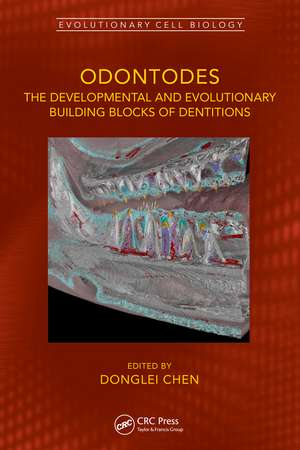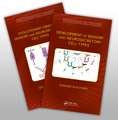Odontodes: The Developmental and Evolutionary Building Blocks of Dentitions: Evolutionary Cell Biology
Editat de Donglei Chenen Limba Engleză Hardback – 8 dec 2023
Key Features
- Summarizes classic and cutting-edge research devoted to the development and evolution
- Focuses on the cellular aspects of odontogenesis
- Documents the structural and functional diversity of odontode tissues
- Describes the patterning mechanisms of dentitions in various vertebrate groups
- Provides a thorough index for students
Preț: 827.09 lei
Preț vechi: 1106.98 lei
-25% Nou
Puncte Express: 1241
Preț estimativ în valută:
158.28€ • 164.25$ • 132.30£
158.28€ • 164.25$ • 132.30£
Carte tipărită la comandă
Livrare economică 15-29 martie
Preluare comenzi: 021 569.72.76
Specificații
ISBN-13: 9781032065151
ISBN-10: 103206515X
Pagini: 376
Ilustrații: 9 Tables, black and white; 17 Line drawings, color; 8 Line drawings, black and white; 28 Halftones, color; 19 Halftones, black and white; 45 Illustrations, color; 27 Illustrations, black and white
Dimensiuni: 156 x 234 x 23 mm
Greutate: 0.85 kg
Ediția:1
Editura: CRC Press
Colecția CRC Press
Seria Evolutionary Cell Biology
ISBN-10: 103206515X
Pagini: 376
Ilustrații: 9 Tables, black and white; 17 Line drawings, color; 8 Line drawings, black and white; 28 Halftones, color; 19 Halftones, black and white; 45 Illustrations, color; 27 Illustrations, black and white
Dimensiuni: 156 x 234 x 23 mm
Greutate: 0.85 kg
Ediția:1
Editura: CRC Press
Colecția CRC Press
Seria Evolutionary Cell Biology
Public țintă
Postgraduate, Professional, and Undergraduate AdvancedCuprins
1. On dental cell types and cell populations, also in light of evolution. 2. The conquest of the oropharynx by odontogenic epithelia. 3. The neural crest and development of odontoskeletogenic potential along the body axis. 4. Evolutionary genomics of odontode tissues. 5. Odontoblast repertoire delivers significantly different dental tissues from pluripotent neural crest derived cells. 6. Shifting perspectives in the study of amniote tooth attachment and the path forward to establishing vertebrate periodontal tissue homology. 7. Initiation and periodic patterning of vertebrate dentitions. 8. The selected deviation: the acquisition of in situ tooth replacement by creating a gap to fill. 9. Complexity, networking and many model thinking enhance understanding of the patterning, variation and interactions of human teeth and dental arches.
Notă biografică
Born in Guangzhou, China, Dr Donglei Chen has studied and worked at Uppsala University in Sweden for 15 years. She studied for her PhD under the supervision of Prof. Per Ahlberg, focusing on the dentitions of the Silurian (approximately 420 to 425 million years old) osteichthyans Andreolepis and Lophosteus. This research was based on microtomographic data sets with sub-micrometer resolution produced at the European Synchrotron Radiation Facility (ESRF) in Grenoble, France, and was the first use of such data to fully reconstruct the three-dimensional architecture of early vertebrate dentitions. She received the Photon Science Award 2018, awarded by the Centre for Photon Science at Uppsala University, for the most innovative use of photon science in a PhD thesis.
Her research has provided profound mechanistic insights allowing her to address evolutionary and developmental questions, such as the origin of teeth in jawed vertebrates, the origin of in situ tooth replacement in bony fish, and the relationship between teeth and dermal odontodes. Based on synchrotron microtomography, she is using three-dimensional virtual histology to reconstruct the ontogenetic histories of early vertebrate dermoskeletons. This three-dimensional ‘reverse engineering’ of ontogeny allows cell behaviors, such as the spatial regulation of odontoclast and osteoclast activity within the resorption zones, to be inferred in fossils and compared with those of living animals. It opens the door to integrating different strands of cutting-edge research, from developmental genomics to paleohistology, in order to explore current topics about the evolution, development and patterning of teeth.
Her research has provided profound mechanistic insights allowing her to address evolutionary and developmental questions, such as the origin of teeth in jawed vertebrates, the origin of in situ tooth replacement in bony fish, and the relationship between teeth and dermal odontodes. Based on synchrotron microtomography, she is using three-dimensional virtual histology to reconstruct the ontogenetic histories of early vertebrate dermoskeletons. This three-dimensional ‘reverse engineering’ of ontogeny allows cell behaviors, such as the spatial regulation of odontoclast and osteoclast activity within the resorption zones, to be inferred in fossils and compared with those of living animals. It opens the door to integrating different strands of cutting-edge research, from developmental genomics to paleohistology, in order to explore current topics about the evolution, development and patterning of teeth.
Descriere
The odontode system, which generates dermal teeth and other structures, is ancient. Among the oldest fossils dating back 500 million years. There is a long history of research on odontodes. Fossils preserve odontode tissues with remarkable nanoscale fidelity. This synthetic volume is an overview of odontode research.















